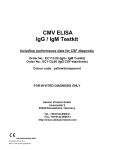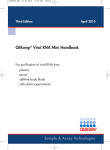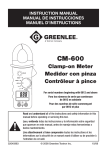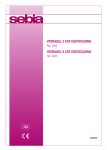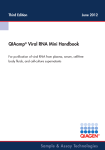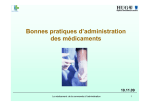Download Package Insert - Sekisui Diagnostics
Transcript
CSF-Standards Order-No.: Borrelia afzelii+VlsE IgG Borrelia afzelii IgM CMV EBV FSME/TBE HSV 1 (gG1) HSV 2 (gG2) HSV Screen Measles Mumps VZV VZV IgG IgM IgG IgG IgG IgG IgG IgA IgG IgG IgG IgA EC022L60 EC022L80 EC113L60* EC102L60 EC117L60 IgM EC130L60 EC131L60 EC108L40 IgG EC105L60 IgM EC106L60 EC110L60 IgM EC110L40 EC117L80 EC108L60 EC105L80 EC110L80 Please also refer to our CSF diagnostic test, with separate instructions for Rubella IgG EC109L00 FOR IN-VITRO DIAGNOSIS ONLY Sekisui Virotech GmbH Löwenplatz 5 D- 65428 Rüsselsheim Tel.: +49-6142-6909-0 Fax: +49-6142-966613 http://www.sekisuivirotech.com * m dc Notified Body 0483 Druckdatum 03.02.2014 REV 26 / Liquor Standards ELISA IgG/IgM/IgA GB Contents 1. Intended Use ......................................................................................................................... 3 2. Diagnostic Relevance ............................................................................................................ 3 3. Test Principle......................................................................................................................... 3 4. Package Contents ................................................................................................................. 3 5. Storage and Shelflife of the Testkit and the ready to use reagents ....................................... 4 6. Precautions and Warnings .................................................................................................... 4 7. Test Procedure ...................................................................................................................... 4 7.1 7.2 7.3 7.4 8. Test Evaluation ...................................................................................................................... 6 8.1 8.2 8.3 8.4 8.5 9. Examination Material....................................................................................................................................................... 4 Preparation of Reagents ................................................................................................................................................. 5 Virotech ELISA Test Procedure....................................................................................................................................... 5 Usage of ELISA processors ............................................................................................................................................ 6 Test function control........................................................................................................................................................ 6 Interpretation ................................................................................................................................................................... 6 Calculation of the antibody index AI (w ith example) ........................................................................................................ 6 Interpretation ................................................................................................................................................................... 8 Limits of the Test............................................................................................................................................................. 8 Literature ............................................................................................................................... 8 10. Test procedure Scheme – Serum and CSF Diagnostic ........................................................ 10 Seite 2 v on 11 Liquor Standards ELISA IgG/IgM/IgA GB REV 26 Druckdatum 03.02.2014 1. Intended Use The CSF-Standards are intended for draw ing up of a calibration curve w hich is used for detection of CNS-ow n antibody synthesis by parallel examination of Serum-CSF-pairs. The pathogen-specific quotient of CSF and serum is calculated. The ratio betw een this pathogen-specific antibody quotient and the total immunoglobulin quotient is called antibody-index (AI). 2. Diagnostic Relevance During acute infections of the central nervous system (CNS) and also during chronical inflammatory processes (e.g. multiple sclerosis) pathogen-specific antibodies are developed in the CNS. In the first case those are antibodies against the caus ative pathogen, in the second case a poly-specific intrathecal immune response against possibly several pathogens without actual pathogen presence is possible (1, 2). Bacterial infections of the CNS are mainly distinguished by highly pathologic and quite characteristic CSF-results. The diagnostic detection of viral CNS infections in cerebral-spinal fluid (CSF) is, depending on stage of infection and individual status of immunity, possible in tw o ways: by direct antigen detection or by detection of pathogen-specific antibodies. It is w ell known that culture of viral pathogens – unlike bacterial pathogens - is complicated, alternative pathogen-specific testings are bound to high methodical efforts. The pathogen-specific antibody detection usually takes effect earliest 6 days after onset of disease, but is routinely used in CSF-diagnosis by now (3). The antibodies detected in the CSF may either diffuse out of the plasma into the CSF-area or be result of a local synthesis (intrathecal antibody production). The specific antibody-index (AI), describing the relation betw een the specific antibody quotient and the total immunoglobulin quotient serves for the clarification of a CNS infection. A local antibody-synthesis is present, if the pathogen-specific antibody quotient of a certain antibody -class is bigger than the corresponding totalimmunglobulin-quotient (Qtotal ). (Please refer to our CSF diagnostic booklet for further information). 3. Test Principle The antibody searched for in the human serum and CSF forms an immune complex w ith the antigen coated on the micr otiter-plate. Unbound immunoglobulins are removed by w ashing processes. The enzyme conjugate attaches to this complex. Unbound conjugate is again removed by w ashing processes. After adding the substrate solution (TMB), a blue dye is pr oduced by the bound enzyme (peroxidase). The color changes to yellow w hen the stopping solution is added. The extinction (OD) of the color solution is directly proportional to the concentration of the analysed pathogen-specific IgG-, IgM- respectively IgA-antibody in Serum and CSF. For the detection of CNS-ow n antibody-synthesis it is necessary to proceed a quantification of the antibody concentrations that are available in extinctions initially. For this, the arrays of standard sera w ith graded pathogen-specific antibody-concentration are provided. Those standard sera serve for the creation of a reference curve, that can be made manually or by using a suitable programme and allow s the conversion of the detected ODvalues into arbitrary defined non-dimensional measurement units (w ME). By allocating of the obtained measurement units (w ME) w ith the nephelometrical measured Sera- and CSF-Total-IgG-, IgM- respectively IgA-concentrations the so called antibody index (AI) is detected (refer to the calculation of the AI in point 8.3). This antibody index mentions the searched pa thogen-specific antibody quotient as a multiple respectively as a fraction of the respective Total-Immunoglobuline-Quotient. The value is therefore independent from the condition of the individual cerebral barrier -function. The antibody-index allow s the conclusion to the presence and dimension of a CNS-ow n synthesis of pathogen-specific antibodies. This method is not valid in case of a poly-specific intrathecal immunoglobuline-synthesis, as then the toal-IgX-quotient is no longer suitable as barrier parameter and has to be replaced by the so called Limes value (refer to calculation of the Limes Quotient in point 8.3.4 B). 4. Package Contents Standards for the quantification of pathogen-specific antibody concentrations, 4 vials à 1000µl, human s erum w ith proteinstabilizer and preservative, ready to use, 100w ME; 25w ME; 6,2w ME;1,5w ME (w ME = arbitrary measurement units) Seite 3 v on 11 Liquor Standards ELISA IgG/IgM/IgA GB REV 26 Druckdatum 03.02.2014 5. Storage and Shelflife of the Testkit and the ready to use reagents Store the testkit at 2-8°C. The shelf life of all components is show n on each respective label; for the kit shelf life please see Quality Control Certificate. 1. 2. 3. Microtiter strips/single w ells are to be resealed in package after taking out single w ells and stored w ith desiccant at 2-8°C. Reagents should immediately be returned to storage at 2-8°C after usage. The ready to use conjugate and the TMB-substrate solution are sensitive to light and have to be stored in dark. Should there be a color reaction of the substrate dilution due to incidence of light, it is not us eable anymore. Take out only the amount of ready to use conjugate or TMB needed for the test insertion. Additional conjugate or TMB taken out may not be returned but must be dismissed. Material Controls Status Diluted Undiluted After Opening Microtitreplate After Opening Rheumatoid factor Absorbent Conjugate Tetramethylbenzidine Stop Solution Undiluted, After Opening Diluted After Opening After Opening After Opening After Opening Final Dilution (ready-to-use) Test Samples Washing Solution 6. Shelflife max. 6h 1 w eek 3 months 3 months 3 months 1 w eek 3 months 3 months 3 months 3 months 4 w eeks Precautions and Warnings 1. 2. 3. 7. Storage +2 to +8°C +2 to +8°C +2 to +8°C +2 to +8° (storage in the provided bag w ith desiccant bag) +2 to +8°C +2 to +8°C +2 to +8°C (protect from light) +2 to +8°C (protect from light) +2 to +8°C +2 to +8°C +2 to +25°C Only sera w hich have been tested and found to be negative for HIV -1 antibodies, HIV-2 antibodies, HCV antibodies and Hepatitis-B surface-antigen are used as standards. Nevertheless, samples, diluted samples, standards, conjugate and microtiter strips should be treated as potentially infectious material. Please handle products in accordance with laboratory directions. Those components that contain preservatives, the Citrate Stopping Solution and the TMB have an irritating effect to skin, eyes and mucous. If body parts are contacted, immediately w ash them under flow ing water and possibly consult a doctor. The disposal of the used materials has to be done according to the country -specific guidelines. Test Procedure Working exactly ref erring to the Sekisui Virotech user manual is the prerequisite for obtaining correct results. 7.1 Examination Material Either serum or plasma can be used as test material, even if only serum is mentioned in the instructions. Any type of antic oagulant can be used for plasma. Consider the follow ing for the serum sam ples: Alw ays prepare patient-dilution freshly. For a longer storage the sera must be frozen. Repeated defrosting should be avoided. 1. Only fresh non-inactivated sera should be used. 2. Hyperlipaemic, haemolytic, microbially contaminated and turbid sera should not to be used (false positive/negative r esults). Consider the follow ing for the CSF sam ples Alw ays prepare patient-dilution freshly. If the CSF samples are to be stored for an extended period, it is best to aliquot them and then to freeze them at -80°C. This avoids repeated thaw ing. 1. Vein- and lumbar puncture should alw ays be performed at approx. the same time. 2. Only optically clear and uncelled and not inactivated CSF may be used. 3. Do not use haemolytic or microbiologically contaminated or turbid CSF. Seite 4 v on 11 Liquor Standards ELISA IgG/IgM/IgA GB REV 26 Druckdatum 03.02.2014 4. 7.2 The use of deepfrozen CSF is possible if after thaw ing the conditions of items 2 and 3 are fulfilled. Preparation of Reagents The Sekisui Virotech System Diagnostica offers a high degree of flexibility regarding the possibility to use the dilution buffer, w ashing solution, TMB, citrate stopping solution as w ell as the conjugate for all parameters and for all different lots.The standards are parameter specific and only to use w ith the plate lots they are related to. Please refer to Quality Control Certificate of the serum kit for possible combinations of plate lots and standard lots. 1. Set incubator to 37°C and check proper temperature setting before start of incubation. 2. Bring all reagents to room temperature before opening package of microtiter strips. 3. Shake all liquid components w ell before use. 4. Make up the w ashing solution concentrate to 1 L w ith distilled or demineralised w ater. If crystals have formed in the concentrate, please bring the concentrate to room temperature before use and shake w ell before use. 5. IgM-Diagnostic: Pre-absorbance with RF-SorboTech High IgG-titer or rheumatoid factors may disturb the specific detection of IgM-antibodies and may lead to false positive resp. false negative results. Hence for correct IgM determination it is necessary to pre-treat the sera and fluids w ith RF-SorboTech (VIROTECH-adsorbent). Please make sure: to use the green dilution buffer in the case of VZV IgM. Pre-absorption is not necessary for the IgM controls and the standards. 6. HSV Screen IgA Determination Please note that the IgA conjugate (catalogue number 131301) is not contained in the kit, so that it must be given separately w hen ordering the CSF standard. We also recommend including the corresponding antibody -index controls to check the test run (catalogue number EN108L45). 7.3 Virotech ELISA Test Procedure CSF/serumpairs are principally to be analysed next to each other in the same determination row on one test plate We recommend a double insertion for blank, controls, standard sera, patient sera and CSF-samples. To minimize matrix effects as much as possible, a w orking-dilution of 1+1 for CSF and 1+400 for serum is used. It is recommended for IgM Diagnostics in general that a start be made w ith a dilution of 1:100 follow ed, if necessary, ( - the 100w ME measurement point exceeded) by a 1:400 dilution. Please carry out the pre-treatment w ith RF-SorboTech for IgM diagnostics. (Please make sure: to use the green dilution buffer in the case of VZV IgM). 1. For each test run, pipette 100µl each of the dilution buffer (blank), the ready-to-use standard sera, the ready-to-use AI controls (if available) or serum quality controls and the diluted CSF and serum samples. Working dilutions of the serum samples: IgG: 1+400 e.g. 5µl serum + 2ml dilution buffer. IgM: 1+100 e.g. 10µl serum + 1ml dilution buffer. IgA: 1+400 e.g. 5µl serum + 2ml dilution buffer. Working dilution of sera: 1 + 400; e.g. 5µl serum + 2m l dilutionbuffer, Working dilution of CSF: 1+1; e.g. 150µl CSF + 150µl dilutionbuffer. 2. After pipetting start incubation for 30 m in. at 37°C (w ith cover). 3. End incubation period by w ashing microtiter strips 4 tim es with 350-400µl washing solution per w ell. Do not leave any w ashing solution in the w ells. Remove residues on a cellulose pad. 4. Pipette 100µl of ready to use conjugate into each w ell. 5. Incubation of conjugates: 30 m in. at 37°C (w ith cover). 6. Stop conjugate incubation by w ashing 4 tim es (pls. refer to 3. above). 7. Pipette 100µl of ready to use TMB into each w ell. 8. Incubation of substrate solution: 30 m in at 37°C (w ith cover, keep in dark). 9. Stopping of substrate reaction: pipette 50µl of citrate stopping solution into each w ell. Shake plate carefully and thoroughly until liquid is completely mixed and a homogeneous yellow color is visible. 10. Measure extinction (OD) at 450/620nm (Reference Wavelength 620-690nm). Set your photometer in such a w ay that the blank value is deducted from all other extinctions. Extinctions should be measured w ithin 1 hour after adding the stopping solution! Seite 5 v on 11 Liquor Standards ELISA IgG/IgM/IgA GB REV 26 Druckdatum 03.02.2014 Pls. refer to last page for Test Procedure Scheme 7.4 Usage of ELISA processors All Sekisui Virotech ELISAs can be used on ELISA processors. The user is bound to proceed a validation of the devices (processors) on a regular basis. Sekisui Virotech recommends the follow ing procedure: 1. Sekisui Virotech recommends to proceed the validation of device referring to the instructions of the device manufacturer during the implementation of the ELISA processor respectively after bigger reparations. 2. It is recommended to check the ELISA-processor w ith the Validationkit (EC250.00) afterw ards. A regular check using the Validationkit shall be proceeded minimum once a quarter to test the accuracy of the processor. 3. The release criteria of the Quality Control Certificate of the product must be fulfilled for each testrun. With this procedure, your ELISA processor w ill function properly and this w ill support quality assurance in your laboratory. 8. 8.1 Test Evaluation Test function control To guarantee the optimal function of the test kit, the OD values of the 100 arbitrary units IgG, IgM and. IgA antibody standard serums must be above the minimal values given in the quality control certificates. When using the AI controls, keep to the ranges given in the control certificate. If there are no AI controls, the validity of the test run must be checked w ith the serum quality controls. a) OD values The OD of the blank should be <0.15. The OD values of the negative controls should be under the OD values given in the quality control certif icate. The OD values of the positive controls and of the cut-off controls should be above the OD values given in the quality control certificate. b) Virotech Units (VE) The Virotech Units (VE) of the cut-off controls are defined as 10 VE. The calculated VE of the positive controls should be w ithin the ranges given in the quality control certificate. If the requirements (OD values, VE) are not fulfilled, the test must be repeated. 8.2 Interpretation For CSF diagnostic testing, calculation through the cut-off control - as in serology - is not possible! To quantify the pathogen-specific antibody content of serum-CSF pairs, a reference curve is prepared, either manually or instrumentally, w ith the help of the IgG-, IgM- or IgA antibody standard sera. The OD values of the standard sera are plotted on the y-axis and the antibody concentrations in w ME on the x-axis. The reference curve, created by hand or by instrument (100w ME, 25w ME, 6.2w ME, 1.5w ME) shall have a sufficiently steep curve, a curve origin near the zero c oordination point and acceptable deviation of all curve points from the extrapolished curve-course. The OD values of the serum-CSF pairs can now be expressed in w ME by reading off from the curve and after multiplication by the appropriate dilution factor (100/400 for serum, 2 for CSF) they correspond to the concentrations of the pathogenspecific IgG, IgM or IgA antibody in serum and CSF.. To obtain plausible antibody indices, OD-values below 0,05 and w MEvalues below 1,5 or above 100 shall not be considered for the calculation When the OD values measured lead to values greater than 100w ME then greater serum dilutions than 1+100 / 1+400, or a greater CSF dilution than 1+1 can be used, w hile taking the changed dilution ratios into account. Virotech provides user friendly CSF softw are solutions to simplify the AI calculation. 8.3 Calculation of the antibody index AI (with example) Abbreviations: IgXtotal =Total IgX (IgG, IgM or IgA, mg/l) IgXspec. = pathogen-specific IgX (IgG, IgM or IgA) Q = Quotient Qalb = Quotient resulting from the albumin content of CSF and albumin content of the serum (mg/l)/only necessary for calc ulation of Limes value! Seite 6 v on 11 Liquor Standards ELISA IgG/IgM/IgA GB REV 26 Druckdatum 03.02.2014 8.3.1 QIgXspec (pathogen-specific antibody quotient) Serum - OD-values read: 0,700 - thus established concentration from the reference curve: 3,5 w ME - dilution: 1:400 CSF - OD-values read: 0,500 - thus established concentration from the reference curve: 2,5 w ME - dilution: 1:2 Q IgXspec. 8.3.2 IgXspec.CSF (wME) x dilution 2,5wME x 2 3,6 x 10 -3 IgXspec.Serum (wME) x dilution 3,5wME x 400 QIgX (Total Im m unoglobulin Value: Value of the clinical chem ist ry) - IgXCSF= 33mg/l - IgXSerum= 10000mg/l QIgXtotal 8.3.3 IgXtotal CSF 33mg/l 3,3 x 10 -3 IgXtotal Serum 10.000mg/l Calculation of the Lim es Quotient (QLIM) In case of an additional poly-specific intrathecal immunoglobulin synthesis, the Total-IgX-Quotient for the AI-determination is no longer suitable. The so called QLIM has to be used instead of the Total-IgX-Quotient. Therefore it is necessary to determine the albumin quotient additionally (value of the clinical chemistry). Calculation of the LIMES-Value (according to Reiber): Q LIM-IgG 0,93 x Q alb2 6 x 10 -6 1,7 x 10 -3 Q LIM -IgM 0,67 x Q alb 2 120 x 10 - 6 7,1 x 10 - 3 Q LIM -IgA 0,77 x Q alb 2 23 x 10 - 6 3,1 x 10 - 3 8.3.4 Calculation of the Antibody Index (AI) A. QIgX < QLIM The antibody index (AI) states the relation betw een the pathogen-specific antibody quotient (Qspec ) and the totalimmunoglobulin-quotient (Qtotal ). Thus, a pathogen-specific antibody-synthesis can be detected and quantified. In this case, the total-immunoglobulin-quotient is used as barrier-parameter. IgX spec.CSF x dilution 3,6x10-3 Q IgX spec. IgX spec.Serum x dilution AI 1,1 IgX total CSF Q IgX total 3 3,3x10 IgX total Serum B. QIgX > QLIM In case an additional poly-specific intrathecal immunoglobulin-synthesis is present the measured Qtotal must no longer be used for the AI-calculation as an antibody synthesis searched for or eventually present at the same time may be falsified in its extent or even get totally unrecognizable. In this cases the so called Limes value of the immunoglobulin quotient is calcu- Seite 7 v on 11 Liquor Standards ELISA IgG/IgM/IgA GB REV 26 Druckdatum 03.02.2014 lated (see formula) or graphically determined by using the albumin quotient w hich has to be calculated additionally. This L imes value is used instead of the immunoglobulin quotient for calculation of AI-value. AI 8.4 Q IgX spec. Q Lim Interpretation AI –Evaluations (4): 1. 2. 3. 4. 8.5 AI: < 0.6 undetectable Should not theoretically occur. Occasionally found in routine w ork. No pathological significance. Desirable to search for errors. AI: 0.6 – 1.3 normal: Intrathecale antibody production is improbable. AI: 1.4 – 1.5 borderline: It is recommended that the sample should be retested, or that a later s erumCSF pair should be tested. AI: >1.5 pathological: Indicates intrathecal antibody production. Since a minimum of four different results (pathogen-specific CSF- and serum-antibody measurement-units, total serumand CSF-IgG-, IgM- or IgA-value, CSF- and serum-albumine in mg/l) are considered for the calculation of the diagnostical relevant AI-value, all methodic and coincidental errors add up here. In the most unfavourable case, a continuing mistake in the same sense is possible; a double determination or better the measuring of tw o different sample dilutions are the best w ay to recognize this. For this reason, a clinical relevant limited AI value of 1,5 has established as note for a local synthesis of pathogen-specific antibodies in the CSF. Normally for virusspecific antibodies of the IgG-, IgM- or IgA-class there is the same ratio betw een CSF and serum as it is found for the summarised IgG-, IgM- or IgA-fraction. The theoretically expected AI-value is therefore 1,0. Corresponding tests have show n, that for all virus-specific antibodies a reference-range of 0,6 – 1,3 is valid. AI values betw een 1.4 – 1.5 are classified as borderline. AI-values above 1,5 may be considered as pathologic in case of sufficient analytical quality of all incoming single values and may be characterized by a CNS-ow n synthesis of the corresponding virus-specific antibodies. AI-values below 0,6 are theoretically impossible and do normally point out an analytical mistake. Only high AI-values w ithout corresponding clinical reference do not allow a definite conclusion for an acute stage of an infectious CNS-disease. Long-time persisting and poly-specific CNS-ow n antibody-synthesis in particular of the IgG-class but also of the IgM-class are possible. IgM-AI-increases are usually considered as prove for florid CNS-infections. In case of doubt, the significant change of the AI-value from a second determination, similar to titer motion, is of advantage for the judgement of an infection of the central nervous system. Such a control is mandatorily bound to a further CSFw ithdrawel, taken in an adequate time interval. How ever, for its indication only the clinical aspects are decisive, as a rule. Limits of the Test 1. 2. The interpretation of serological results shall alw ays include the clinical picture, epidemiological data and all further ava ilable laboratory results. In case of very high pathogen-specific antibody concentrations in the cerebrospinal fluid or in the serum, a risk that the antigen-concentration in the w ells is insufficient to fulfill the optimum conditions for a quantitative antibody detection is present. If an antibody-excess is suspected (please consider also Heidelberg curve and total CSF-result) a second determination w ith higher dilution of serum respectively CSF has to follow . Notice the detailed performance data (sensitivity and specificity) for Borrelia – and CMV – CSF diagnostic in the regular instruction sheet in addition to the serology. 9. Literature 1. 2. Zimmermann K. , Liquordiagnostik, MTA 11 (1996)4 ; 258 - 260 Reiber H, Lange P., Virus-spezifische Antikörper in Liquor und Serum . ELISA -Analytik und Auswertung mittels Antikörper-Index und Quotientendiagramm, Lab.med. 15: 204 (1991) 204 - 207 Seite 8 v on 11 Liquor Standards ELISA IgG/IgM/IgA GB REV 26 Druckdatum 03.02.2014 3. 4. Linke E, Zimmermann K: Liquordiagnostik; hauseigene Liquorbroschüre 2003 Petereit, Sindern, Wick (2007): Leitlinien der Liquordiagnostik und Methodenkatalog der Deutschen Gesellschaft für Liquordiagnostik und Klinische Neurochemie, Springer Verlag, ISBN 978-3-540-39017-6 Seite 9 v on 11 Liquor Standards ELISA IgG/IgM/IgA GB REV 26 Druckdatum 03.02.2014 10. Test procedure Scheme – Serum and CSF Diagnostic Preparation of the Patient Samples and Washing Solution ▼ Washing Solution: Fill up concentrate to 1 liter with aqua dest./demin. ▼ ▼ IgG/IgA-Samples – Dilution 1:401 ▼ IgM-Samples – Dilution 1:101/1:401 ▼ CSF-Dilution 1:2 CSF-Dilution 1:2 Rheumatoid factor-absorption with RFSorboTech e.g.: 5 µl serum/plasma + 2000 µl Dilution Buffer (Serum Dilution Buffer is ready to use) 150 µl CSF-sample + 150 µl Dilution Buffer e.g.: 1:101: Incubate 5 µl serum/plasma + 450 µl dilution buffer + 1 drop RF-absorbent RT for 15 min 1:401: 100 µl serum/VP/RF-SorboTech mixture +300 µl dilution buffer 45 µl RF-SorboTech + 180 µl Dilution Buf fer + 225 µl CSF-sample, incubate for 15 min at room temperature Test procedure Samples Incubation 30 Minutes at 37°C 100 µl Patient Samples blank (Dilution Buffer) and Standards 400 µl Washing Solution Wash 4 times Remove Residues on a Cellulose Pad Conjugate Incubation 30 Minutes at 37°C 100 µl Conjugate IgG, IgM, IgA 400 µl Washing Solution Wash 4 times Remove Residues on a Cellulose Pad Substrate Incubation Stopping 30 Minutes at 37°C 100 µl Substrate 50 µl Stopping Solution shake carefully Measure Extinctions Photometer at 450/620nm (Reference Wavelength 620690nm) Seite 10 v on 11 Liquor Standards ELISA IgG/IgM/IgA GB REV 26 Druckdatum 03.02.2014 Seite 11 v on 11 Liquor Standards ELISA IgG/IgM/IgA GB REV 26 Druckdatum 03.02.2014












